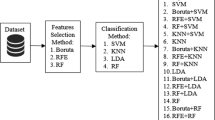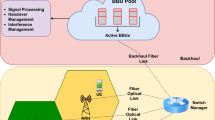Abstract
Due to the rapid development of the wireless communication technology, the data volume of 5G mobile network continues to grow, which leads to the continuous reduction of signaling analysis and processing efficiency. To overcome the problem, the intelligent communication will be one of the mainstream directions of mobile communication development which combines with 5G and AI. In this paper, we introduce a method of using machine learning classification and signaling analysis technology. The proposed method in this paper is an improved signaling analysis algorithm based on naive Bayesian classification, which improves the signaling classification accuracy of the algorithm. In the signaling analysis process of the algorithm, the key messages of signaling data are selected as user characteristics before the association and synthesis of user signaling processes. Then, the supervised signaling feature classification model is trained according to the user ID in the signaling data, and the model is used for signaling classification. Subsequently, aiming at the zero probability problem in the algorithm, we use Laplace smoothing to correct it. Then, the algorithm continues to use orthogonal matrix to make orthogonal transformation on continuous attributes and discrete attributes after numerical marking, so as to enhance the independence between attributes. It closes to the assumption of naive Bayes, which improves the classification accuracy of the algorithm. The experimental results show that the improved algorithm model has high comprehensive performance index and good classification performance. The F1 score of this algorithm reaches 67.86%, and achieves the expected effect. The improved signaling analysis method proposed in this study is expected to be useful in 5G network optimization and testing.










Similar content being viewed by others
Data availability
In the paper, this dataset is the cellphone CDR data of the Chinese city Shenzhen for 1 Day. This dataset is for academic research only. All rights reserved. For privacy concerns, all specific date info was removed and all identifiable IDs have been replaced by serial numbers in each kind of data.
References
Buggenhagen M, Blind K (2022) Development of 5G – identifying organizations active in publishing, patenting, and standardization. Telecommun Policy 46(4):102326. https://doi.org/10.1016/j.telpol.2022.102326
Narayanan S, Liberg O, Höglund A, Tsolkas D, Passas N, Merakos L (2022) Sidelink optimizations for layer-3-based IoT relaying in 5G NR. IEEE Internet of Things Mag 5(2):140–145
Ahmed ST, Kumar VV, Singh KK, Singh A, Muthukumaran V, Gupta D (2022) 6G enabled federated learning for secure IoMT resource recommendation and propagation analysis. Comput Electr Eng 102:108210
Xu W (2022) Discussion on the development trend of new media information dissemination methods in the 5G Era. Springer Nature Singapore, pp 333–340
You X, Zhang C, Tan X (2019) AI for 5G: research directions and paradigms. Sci China (Inform Sci) 62(02):5–17
Zhang Z, Mao Y, Zhu L (2020) Progress and challenge of mobile communication testing technology. Data Acquis Process 34(06):974–985
Zhang Z, Cheng F (2021) Cellular architecture and key technologies for 5G mobile communication networks. J Chongqing Univ Posts Telecommun 26(04):427–430
Li L, Zhang Z, Xi B (2019) Research and implementation of multi-protocol association scheme on Uu interface in LTE-Advanced network. Telecommun Sci 32(6):167–176
Duan Yu, Longhan C, Zhizhong Z (2021) Research and implementation of signaling analysis technology in 5G Terminal simulator. Comput Eng Appl 56(18):173–181
Peng L, Longhan C, Zhizhong Z (2020) Research and implementation of user behavior analysis system for LTE advanced network Uu interface. Telev Technol 41(Z4):135–140
Pingbao Lu, Qing B, Wei Yu (2020) New RRC status in 5G and its application in mobility management. Telecom Express 53(5):12–15
He H, Wen CK, Jin S (2018) (2018) Deep learning-based channel estimation for Beamspace mmWave massive MIMO systems. IEEE Wirel Commun Lett 99:852–855
Chen Y-W, Chuang G-K (2020) New radio access technologies for 5G with enhanced network reliability and channel capacity. SPIE 11307:08-6
Adali T, Miller DJ, Diamantaras KI (2011) Trends in machine learning for signal processing. IEEE Signal Process Mag 28(6):193–196
Zhang D, Zhao J, Zhang F (2021) UrbanCPS: a cyber-physical system based on multi-source biginfrastructure data for heterogeneous model integration. IEEE Int Conf Cyber-PhysicalSyst 4(2):101–118
Wenxing Wu, Ruiting L (2019) Overview of global 5G development. Digital Commun World 15(5):25–26
Santosh KC (2021) Editorial: current trends in image processing and pattern recognition. Front Robot AI 8:785075
Cao J (2018) Recent advances in machine learning for signal analysis and processing. J Franklin Inst 355(4):1513–1516
Kolouri S, Park SR (2017) Optimal mass transport: signal processing and machine-learning applications. IEEE Signal Process Mag 34(4):43–59
Chen Haihua Wu, Lei CJ (2022) A comparative study of automated legal text classification using random forests and deep learning. Inf Process Manage 59(2):556–571
Mustafa Hilal A (2022) Malware detection using decision tree based SVM classifier for IoT. Comput Mater Contin 72(1):713–726
Konstantina K (2022) Demonstration of a hybrid analog-digital transport system architecture for 5G and beyond networks. Appl Sci 12(4):122–128
Li F-x, Wang J-m, Liang J-c (2022) Optimization of Naive Bayesian classification algorithm for discrete attributes. J Chin Comput Syst 43(05):897–901
Zhuoya Ju, Zhihai W (2020) A Bayesian classification algorithcm based on selective patterns. J Comput Res Dev 57(08):1605–1616
Zhu D, Song L, Yu W (2022) An improved naive Bayesian classification method based on symmetric uncertainty 12329:07–14
Wu Z, Xu Q, Li J (2018) Passive indoor localization based on CSI and Naive Bayes classification. IEEE Trans Syst Man Cybern Syst 48(9):1566–1577
Sahoo R, Mishra BK, Das BR (2022) Odia text classification using Naïve Bayes algorithm: an empirical study. ECS Trans 107(1):8175–8180. https://doi.org/10.1149/10701.8175ecst
Zhidong Z, Zhihai W, Haiyang L (2021) An integrated multi-label classification algorithm based on tree Bayesian network. Comput Sci 45(03):191–197
Ordabayev YA, Friedman LJ, Gelles J, Theobald DL (2022) Bayesian machine learning analysis of single-molecule fluorescence colocalization images. eLife 11:475–481. https://doi.org/10.7554/eLife.73860
Zhang H, Jiang L (2022) Fine tuning attribute weighted naive Bayes. Neuro Comput 488:402–411
Duy-Hien V (2022) Privacy-preserving Naive Bayes classification in semi-fully distributed data model. Comput Secur 115:102630
Khongdet P (2022) Analyzing the performance of machine learning techniques in disease prediction. J Food Qual 10(5):701–717
Ahmet Y, Ali D, Asil O, Mark C (2022) A novel text analytic methodology for classification of product and service reviews. J Bus Res 151:287–297
Abdalaziz M, Faroq A, Esam A-R (2022) Case study of TV spectrum sensing model based on machine learning techniques. Ain Shams Eng J 13(2):188–203
Funding
This work is supported by the National Key R&D Program of China (2021YFB2700300); Chongqing Education Commission Science and technology research project (KJQN201902402).
Author information
Authors and Affiliations
Corresponding author
Ethics declarations
Conflict of interest
The authors declare no conflict of interest.
Additional information
Publisher's Note
Springer Nature remains neutral with regard to jurisdictional claims in published maps and institutional affiliations.
Rights and permissions
Springer Nature or its licensor (e.g. a society or other partner) holds exclusive rights to this article under a publishing agreement with the author(s) or other rightsholder(s); author self-archiving of the accepted manuscript version of this article is solely governed by the terms of such publishing agreement and applicable law.
About this article
Cite this article
Wang, W., Duan, Y., Cao, L. et al. Application of improved Naive Bayes classification algorithm in 5G signaling analysis. J Supercomput 79, 6941–6964 (2023). https://doi.org/10.1007/s11227-022-04946-x
Accepted:
Published:
Issue Date:
DOI: https://doi.org/10.1007/s11227-022-04946-x




